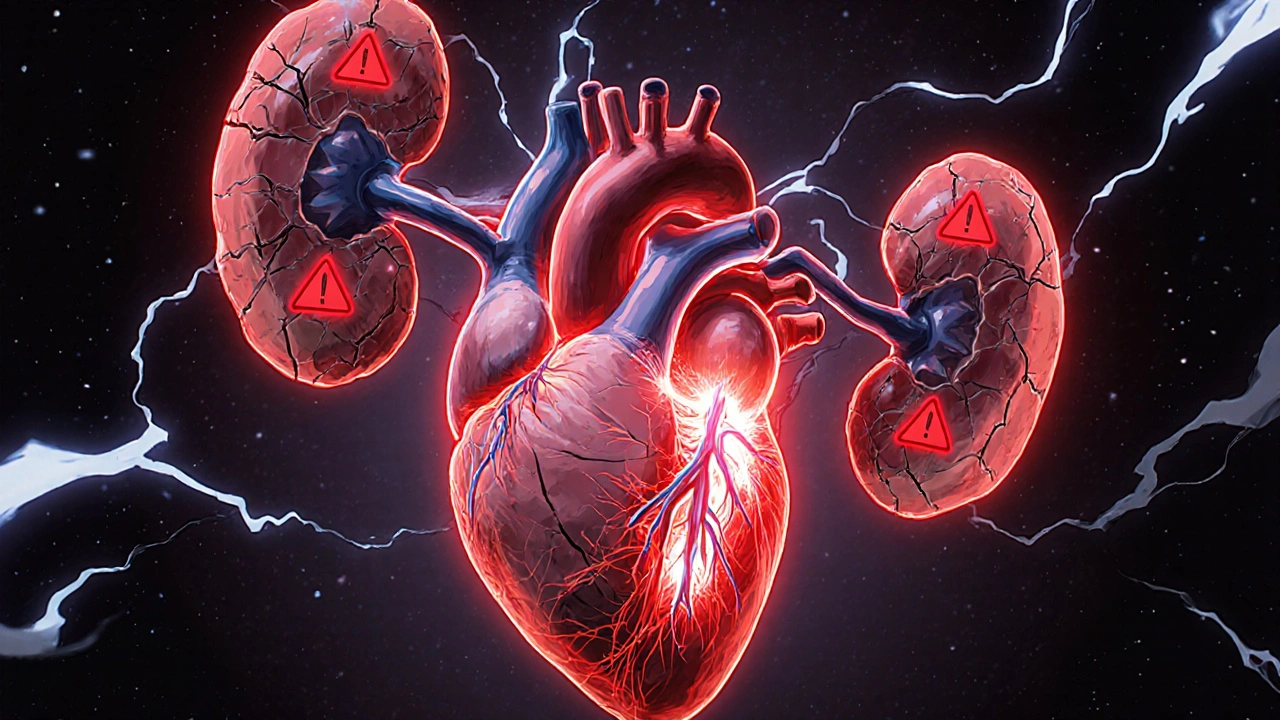Why Electrolyte Imbalances Matter More Than You Think
When your kidneys aren’t working right, your body’s electrolytes go haywire. Potassium, phosphate, and magnesium aren’t just buzzwords in lab reports-they’re the quiet conductors of your heart rhythm, muscle function, and energy production. A drop in potassium below 3.0 mEq/L can trigger dangerous heart rhythms. Too much magnesium can shut down your breathing. Low phosphate can leave you too weak to take a single breath. These aren’t rare edge cases. In hospitals, electrolyte imbalances show up in nearly 1 in 3 patients with kidney disease, and they’re responsible for up to 18.7% fewer deaths when managed correctly.
What Each Electrolyte Actually Does
Potassium keeps your heart beating regularly. It’s the main ion inside your cells, and it tells your muscles when to contract-whether it’s your heartbeat or your bicep. Normal levels sit between 3.2 and 5.0 mEq/L. Below that, you get muscle cramps, fatigue, and irregular pulses. Above 6.5 mEq/L, your heart can stop without warning.
Magnesium doesn’t get the spotlight, but it’s behind the scenes for over 300 enzyme reactions. It’s the key that unlocks energy (ATP) in your cells. Without enough magnesium, your body can’t hold onto potassium-even if you’re taking supplements. Low magnesium (under 1.7 mg/dL) makes low potassium stubborn and hard to fix. And when magnesium drops below 1.0 mg/dL, you risk seizures or cardiac arrest.
Phosphate is your body’s battery pack. It’s tied to calcium for strong bones, but more importantly, it powers every cell. When phosphate falls below 2.5 mg/dL, your muscles weaken. Below 1.0 mg/dL, you can’t breathe on your own. It’s why critically ill patients-especially those getting fed through tubes after being starved-suddenly crash. And here’s the twist: some iron infusions, like ferric carboxymaltose, can drain phosphate right out of your blood. The FDA flagged this in 2020, and doctors now watch for it.
The Hidden Link Between Magnesium and Potassium
You can’t fix low potassium without checking magnesium first. This isn’t optional-it’s medical fact. If your magnesium is low, your kidneys won’t hold onto potassium no matter how much you give. You’ll keep giving IV potassium, and the numbers won’t budge. That’s not treatment failure. That’s missing the root cause.
Studies show that up to 70% of people with persistent hypokalemia also have hypomagnesemia. In cardiac patients, this combo is a death sentence for rhythm stability. The American Heart Association says: check magnesium before you start potassium replacement. If magnesium is low, give 4 grams of IV magnesium over 30 to 60 minutes. Only then should you move on to potassium.
Think of it like this: potassium is water in a bucket. Magnesium is the hole in the bottom. Pouring more water in won’t help if the hole isn’t plugged. Fix magnesium first.

How to Treat High Potassium (Hyperkalemia) in Real Time
High potassium isn’t a lab curiosity-it’s a code situation. If your level hits 7.0 mEq/L and your ECG shows flattened P waves or wide QRS complexes, you have minutes to act.
Here’s the exact sequence used in ERs and ICUs:
- Give 10 mL of calcium gluconate IV over 2-5 minutes. This doesn’t lower potassium-it protects your heart from the chaos.
- Give 10 units of regular insulin with 50 grams of glucose. This shoves potassium back into your cells. Effects start in 15 minutes.
- Use a potassium binder-patiromer or sodium zirconium cyclosilicate. These are newer, safer than old-school kayexalate. Approved by NICE in early 2023, they bind potassium in your gut and flush it out.
- If you’re on dialysis, or your kidneys are failing, hemodialysis is the fastest fix. It can drop potassium by 2 mEq/L in under an hour.
Don’t delay calcium if the ECG is changing. That’s your last line of defense before cardiac arrest.
When Phosphate Drops-And Why It Sneaks Up on You
Hypophosphatemia doesn’t come with warning signs until it’s too late. You might feel fine, then suddenly can’t lift your head off the pillow. Or your breathing gets shallow. That’s because your diaphragm-the muscle that pulls air in-runs on phosphate.
Common causes? Malnutrition, alcoholism, diabetic ketoacidosis, and yes-iron infusions. Ferric carboxymaltose, often used for anemia in kidney patients, can tank phosphate levels within days. The FDA warning changed how doctors give these infusions. Now, they check phosphate before and 24 hours after.
Refeeding syndrome is another silent killer. When a starving patient starts eating again, their cells wake up and suck phosphate out of the blood to make energy. Levels can plummet in 24 hours.
Treatment depends on severity:
- Below 1.0 mg/dL? IV phosphate-7.5 mmol over 4-6 hours.
- Mild drop (1.0-2.0 mg/dL)? Oral phosphate-8 mmol twice daily.
- Never give phosphate too fast. It can cause calcium to drop or deposit in soft tissues.
Monitor calcium closely. Giving phosphate can trigger hypocalcemia. Check levels every 4-6 hours during treatment.
Hypermagnesemia: Rare, But Deadly When It Happens
Magnesium overdose is uncommon outside of kidney failure or excessive antacid use. But when it hits, it’s brutal. Levels above 2.5 mg/dL cause drowsiness. At 4.0 mg/dL, you lose your reflexes. Above 5.0 mg/dL, your heart slows, your breathing stops.
There’s no magic pill. Treatment is simple but urgent:
- Stop all magnesium sources-antacids, laxatives, IV infusions.
- Give 10-20 mL of calcium gluconate IV to reverse muscle and nerve blockade.
- If kidneys are working, give furosemide to flush it out.
- If kidneys are failing, dialysis is the only option.
Patients on dialysis are especially vulnerable. Their bodies can’t clear magnesium. A single dose of magnesium sulfate for preeclampsia can linger for days.

Monitoring: When and How Often to Check
Checking electrolytes once a day isn’t enough when things are unstable. Here’s what real protocols demand:
- After treating hyperkalemia: check potassium at 1, 2, 4, 6, and 24 hours. Levels can rebound.
- During magnesium replacement: check every 6 hours until stable.
- After phosphate infusion: check calcium and phosphate every 4-6 hours for 24 hours.
- For all hospitalized kidney patients: run a full electrolyte panel every 24-48 hours-even if they seem fine.
Point-of-care testing in ERs now cuts the time to treatment by 37 minutes. That’s the difference between a stable patient and a cardiac arrest.
What You Can Do Outside the Hospital
If you have kidney disease, don’t wait for symptoms. Talk to your doctor about:
- Regular blood tests every 3 months (or more often if on diuretics or ACE inhibitors)
- Avoiding salt substitutes (they’re loaded with potassium)
- Watching for signs: muscle weakness, irregular heartbeat, confusion, extreme fatigue
- Asking about phosphate binders if you’re on dialysis
- Never taking magnesium supplements without checking your levels first
Many people with kidney disease take over-the-counter supplements thinking they’re helping. They’re not. A single magnesium pill can push a failing kidney over the edge.
The Future: Personalized Electrolyte Care
Doctors are starting to look beyond lab numbers. Genetic tests are being studied to see how your kidneys handle potassium and magnesium. Phase 3 trials are underway for treatments that adjust doses based on your DNA.
Meanwhile, new phosphate binders are being developed to protect levels in dialysis patients. And hospitals are rolling out smart order sets that auto-flag low magnesium before potassium is given. These aren’t futuristic ideas-they’re happening now.
The bottom line? Electrolytes aren’t just numbers. They’re life-or-death signals. Get them checked. Get them managed. And never treat one without checking the others.
Can low potassium cause heart palpitations?
Yes. Low potassium (below 3.0 mEq/L) can cause skipped beats, fluttering, or rapid heart rhythms. The risk spikes when low potassium happens with low magnesium. This combo is a known trigger for dangerous arrhythmias, especially in people with heart disease or kidney failure.
Why do kidney patients often have low phosphate?
Kidney patients lose phosphate through dialysis, and many take phosphate binders to control high levels-often too aggressively. Also, poor nutrition, vitamin D deficiency, and certain IV iron treatments (like ferric carboxymaltose) can drain phosphate. Refeeding syndrome after long fasting is another common cause in hospitalized patients.
Is it safe to take magnesium supplements if I have kidney disease?
No-not without testing. Healthy kidneys clear extra magnesium. Failing kidneys can’t. Even a single 400 mg supplement can build up to toxic levels. Always check your magnesium level before taking any supplement. Most kidney patients should avoid over-the-counter magnesium unless prescribed and monitored.
What foods should I avoid if I have high potassium?
Avoid salt substitutes (they’re pure potassium chloride), bananas, oranges, potatoes, tomatoes, spinach, and dried fruit. Also limit dairy and nuts. Cooking vegetables by boiling and discarding the water can reduce potassium by up to 50%. Always work with a renal dietitian to build a safe meal plan.
Can electrolyte imbalances be prevented?
Yes. Regular blood tests, avoiding unapproved supplements, managing medications like diuretics and ACE inhibitors, and staying hydrated are key. Hospitals that use standardized checklists and clinical alerts have cut electrolyte-related deaths by over 20%. Prevention is simple, but only if you’re paying attention.





Douglas cardoza
November 24, 2025 AT 18:08Also, that ferric carboxymaltose warning? Real. We stopped using it on dialysis patients unless absolutely necessary. Changed our ICU outcomes.
Adam Hainsfurther
November 26, 2025 AT 15:42Rachael Gallagher
November 26, 2025 AT 17:29steven patiño palacio
November 27, 2025 AT 17:26Victoria Stanley
November 28, 2025 AT 10:01Andy Louis-Charles
November 28, 2025 AT 16:54Don’t do this. Please.
Jacob McConaghy
November 28, 2025 AT 17:31Don’t take supplements without testing. Period. I wish someone had told me this before I almost died.
Natashia Luu
November 29, 2025 AT 21:45akhilesh jha
November 30, 2025 AT 05:12Vineeta Puri
November 30, 2025 AT 07:47stephanie Hill
December 1, 2025 AT 04:05